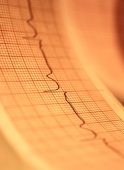
WEDNESDAY, May 12 (HealthDay News) — A new, wireless defibrillator that is easier to implant and maintain could make life better for people who rely on them to prevent sudden cardiac death, researchers report.
A defibrillator delivers an electric shock to restart a heart that has stopped beating. About 100,000 of them are implanted in Americans each year. Current models require careful surgery to run wires from the device through a vein into the heart — a procedure that can damage the heart, a lung or a blood vessel, even when done by the most skilled practitioner.
The new device, developed by Cameron Health, a small California company, does away with those wires and has worked as well as the more complicated existing implanted defibrillators in several studies, according to a report to be released Wednesday at the Heart Rhythm Society annual meeting in Denver.
Another report on two successful trials conducted in 61 patients is also being released early in the May 12 issue of the New England Journal of Medicine.
“It’s an exciting new technology,” said Dr. Richard Page, chair
of medicine at the University of Wisconsin and president of the Heart Rhythm Society. “What we see is a truly innovative approach to the problem of sudden cardiac arrest
and the problems associated with current technology.”
Still, it’s too early to give a full assessment, said Page, who noted that this is the first report on the use of the device.
“It is a relatively small study, and there is much to learn about the effectiveness and reliability of this system over time,” he said.
The new defibrillator “is a small device with enough power to restart the heart while away from it and also sense the heart’s electrical activity while away from it,” said Dr. Gust H. Bardy, a clinical professor of medicine at the University of Washington and founding president of the Seattle Institute for Cardiac Research.
Heart activity — or the lack of it — is detected by electronics that give “three different angles of looking at the heart,” Bardy explained. The device is capable of telling the difference between electronic abnormalities that originate in the heart vs. those that occur outside the heart.
In the two trials reported in the journal, the implanted defibrillator successfully detected all 137 instances of the potentially fatal abnormal heartbeat called ventricular fibrillation. A larger trial that will implant 340 of the devices is now enrolling participants, Bardy said.
“The results will be given to the [U.S.] Food and Drug Administration in the summer of 2011,” he said. “Then it is up to the regulatory authorities.”
The defibrillator already is in use in several European countries, added Dr. Martin Burke, director of the Heart Rhythm Center at the University of Chicago. He took part in the trials that led to European approval and is participating in the new trial.
“There is no question that the entire system, from implanting to programming to postoperative care for patients, is simpler,” Burke said.
The new device might even reduce the cost of implanted defibrillators, both Bardy and Burke said.
Implantation of existing defibrillators now requires expensive fluoroscopy screening, Bardy said. “The new one doesn’t need fluoroscopy and can be installed in 30 minutes,” he said. “That will whittle away at the cost dramatically, and because complications now occur in 10 percent of cases, it can cut costs by eliminating those complications.”
The new defibrillator is implanted alongside the sternum, the chest bone, in a much simpler surgical procedure than is now needed, Bardy said. And if something should go wrong, “removing it is relatively minor surgery compared to removing of one that breaks while an electrode is in a vein,” he said.
“The spectrum of complications goes down and then the overall cost of the implant, both acutely and chronically, improves,” Burke said.
More information
There’s more on implanted defibrillators at the American Heart Association.

